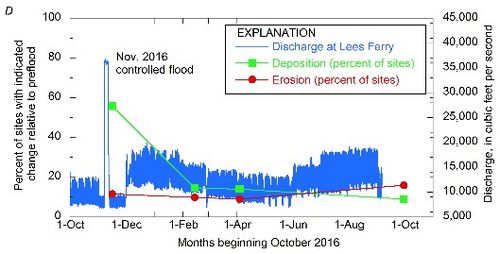Difference between revisions of "The HFE Page"
Cellsworth (Talk | contribs) |
Cellsworth (Talk | contribs) |
||
| Line 134: | Line 134: | ||
|- | |- | ||
|style="color:#000;"| | |style="color:#000;"| | ||
| + | *[[The 2023 Spring HFE| The 2023 Spring HFE]] | ||
*[[A 2022 Fall HFE| A 2022 Fall HFE]] was not conducted due to the discovery of [http://gcdamp.com/index.php/Smallmouth_Bass_Page smallmouth bass] in Glen Canyon (1,600,000 mt) | *[[A 2022 Fall HFE| A 2022 Fall HFE]] was not conducted due to the discovery of [http://gcdamp.com/index.php/Smallmouth_Bass_Page smallmouth bass] in Glen Canyon (1,600,000 mt) | ||
*[[A 2022 Spring HFE| A 2022 Spring HFE]] was not conducted for lack of sediment | *[[A 2022 Spring HFE| A 2022 Spring HFE]] was not conducted for lack of sediment | ||
Revision as of 15:56, 29 June 2023
|
High-Flow Experimental (HFE) ReleasesPurpose and GoalThe purpose of HFEs is to determine if sandbar building during HFEs exceeds sandbar erosion during periods between HFEs, such that sandbar size can be increased or maintained over several years. LTEMP HFE ProtocolAs described in the LTEMP ROD, HFEs are experimental in nature and are designed to achieve a better understanding of whether, how, and when to incorporate high releases into future dam operations in a manner that maintains or improves beaches, sandbars, and associated habitat. The LTEMP HFE Protocol establishes a decision-making framework consisting of three components: (1) planning and budgeting, (2) modeling, and (3) decision and implementation. Under the LTEMP, HFE releases are restricted to limited periods of the year when the highest volumes of sediment are most likely available for building sandbars. Sediment-triggered HFEs may be made in spring (March or April) or fall (October or November; Figure 1). Fall extended-duration HFEs range from greater than 96 hr to 250 hr. Spring and fall HFEs that are not extended-duration range from less than 1 hr to 96 hr. Proactive HFEs may be implemented in spring or early summer (April, May or June), and have a duration range up to 24 hr. HFE magnitudes range from 31,500 cubic feet per second (cfs) to 45,000 cfs. The frequency of HFEs is determined by tributary sediment inputs, annual release volumes, resource conditions, and decisions of the Department. Extended-duration fall HFEs are limited to a frequency of 4 times total in the 20-year LTEMP period. HFE Sand Budget ModelThe LTEMP HFE Protocol uses predictive models to make recommendations for the magnitude and duration of potential HFEs using real-time measurements and models of sand inflow from the Paria River and forecasted hydrologic data to determine whether suitable sediment and hydrology conditions exist for a high-flow experimental release. A sand transport/budget model (Wright et al. 2010) was used to predict the mass of sand that would be transported by an HFE and to estimate if a proposed HFE would transport more or less sand than had been delivered from the Paria River to the Colorado River during the fall accounting period (July 1 to November 30). Only HFE durations that resulted in a “positive sand balance” were considered. Output of the modeling runs provides the initial recommendation for the magnitude and duration of the HFE. However, because modeling only considers a simple range of possible HFE peak magnitudes and durations, the Protocol includes a review of the model output that may modify the recommended HFE to benefit relevant resources. (2018 HFE Tech Team Report) |
| --- | --- | --- |
|---|











